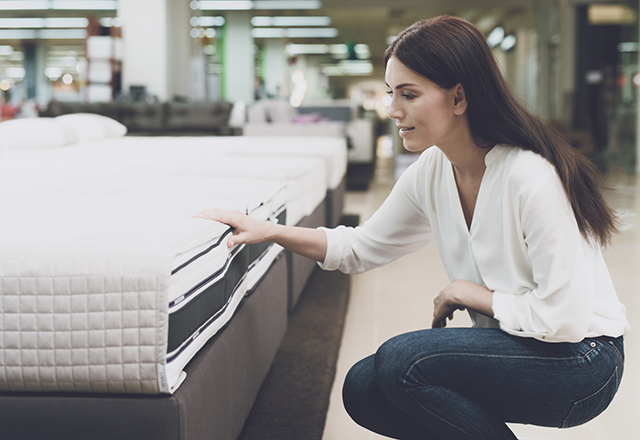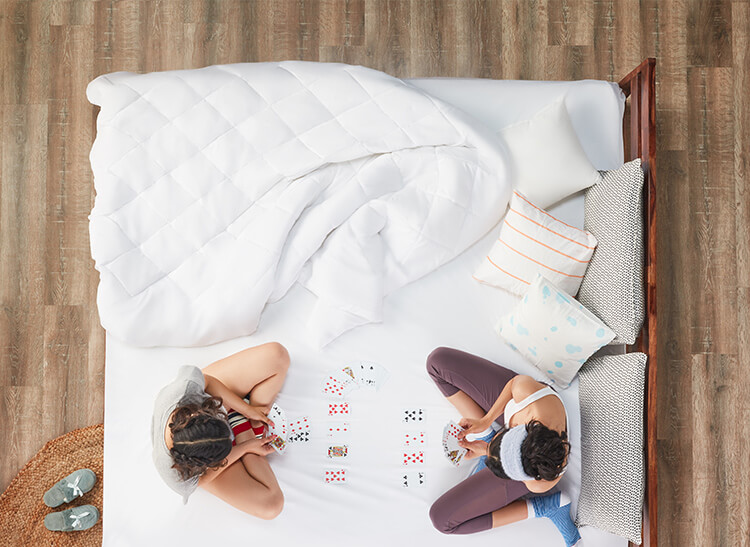It may seem like a bed is a bed, but the average adult spends almost 3,000 hours sleeping in a bed during the course of a year – that’s 122 days! The mattress you pick will make a big difference in your sleep quality, skeletal alignment, how many aches and pains you deal with daily, and your mood and energy levels. It is not a decision to be made on a whim! But with all the options available, what do you look for when buying a mattress? Let’s walk through that process together.
Before we look at the different mattresses, we need to determine your individual needs and sleeping habits
Sleeping Position
First up, what is your preferred sleeping position? While most people move between various positions over the course of a night, if you pay attention, you’ll likely find that you are predominantly a back sleeper, side sleeper, or stomach sleeper.
- Back Sleepers need a medium-firm mattress feel. If the mattress is too firm, you’ll have tension in your shoulders and lower back. If it’s too soft, your hips and shoulders will fall out of alignment, resulting in back pain.
- Side Sleepers will need a mattress that relieves pressure at the shoulders and hips. This means that the softer mattresses are best for you because you’ll contour to the high points of their body.
- Stomach Sleepers, on the other hand, will want a very firm mattress to lift your hips and keep them in line with your shoulders.
Body Type
Your bed doesn’t judge! But your weight and body type will be a factor to consider. How much a mattress sinks, stays cool, supports your spine, or hugs your body will depend, to a large degree, on your weight.
- Lightweight Sleepers (150 lbs or less) rarely sink down past the first few layers of the mattress. Memory foam mattresses are great for lightweight side sleepers. For lightweight sleepers who want a firmer mattress, make sure to prioritize a thin, upper comfort layer. If the top layer of foam or cushion is too thick, you won’t feel the firmness provided deeper in the mattress layers.
- Average Sleepers (150-200 lbs) are the body type most mattress companies rate their firmness scale from. If you prefer a soft mattress, make sure the top layers of foam are nice and thick. If you prefer a firmer mattress, you’ll want to reduce the thickness of the comfort layers and pump up the support layers.
- Plus-Sized Sleepers (200 lbs or more) will sink down into the mattress more. A soft feel mattress needs to be a taller model and have at least four or five inches of foam to press into. For medium or firm mattresses, it’s best to go up a few points on the firmness scale in each category. Keep the top layers of foam thick, but prioritize a study, innerspring mattress.
Now that we have your needs pegged down let’s look at the qualities of the different mattresses.
Memory Foam
Memory foam is a slow-response foam, meaning that it slowly contours to your body and takes a while to return to its original shape. It provides significant pressure relief on the shoulders, hips, and lower back. It is dense, however, and tends to trap body heat. Many manufacturers help relieve this by infusing their foam with copper, gel, or graphite. Side sleepers, in particular, benefit from memory foam mattresses.
Latex Foam
Latex foam is a bouncier foam with a higher response time. It’s also an all-natural material, and it’s naturally cooling! Its ability to rebound shape quickly makes it a great option if you tend to move between positions frequently. It doesn’t provide the deep pressure relief most side sleepers need, however.
Innerspring
Innerspring mattresses may use coils, but these are not the metal springs of yore. These mattresses use various combinations of coil technology to provide a bouncy, supportive, and firm mattress. These are the front runners for back sleepers, stomach sleepers, and plus-size sleepers. More of these are being produced with a cushiony pillow top to add a touch more comfort to the high degree of support.




















